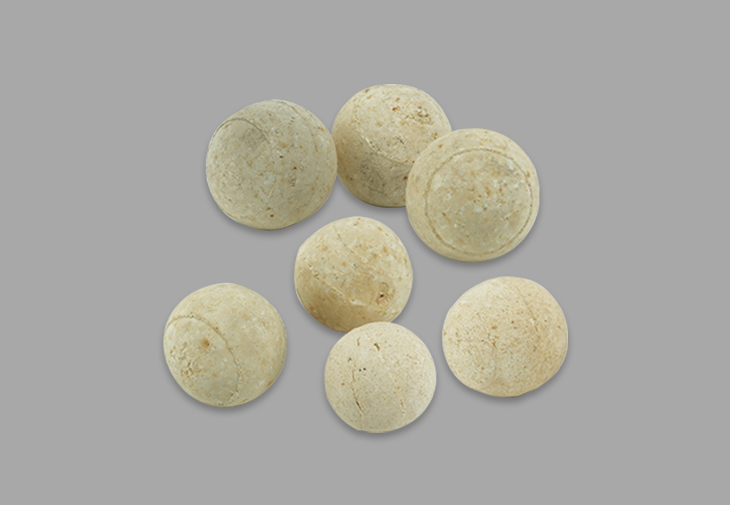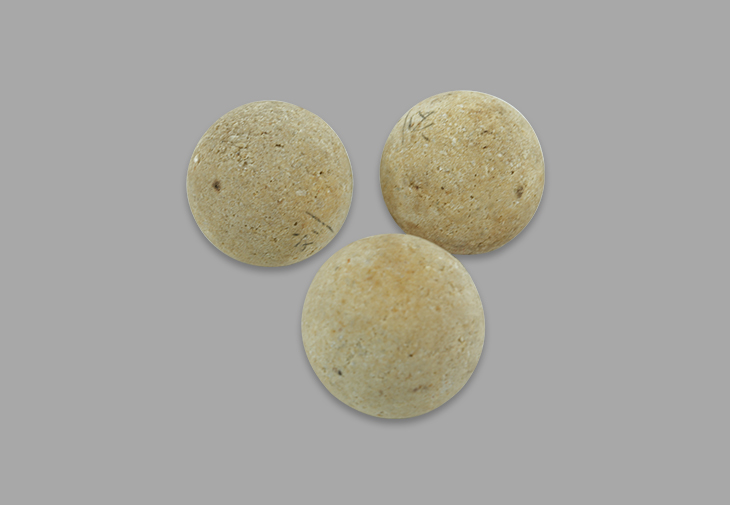
Highland Refractory’s Refractory Ball, a reliable solution for high-temperature industrial needs, includes specialized variants like high alumina refractory ball and Alumina Ceramic Refractory Ball. Key specs vary by grade: high alumina options have Al₂O₃ content 65%-90% (90% for premium) for strong wear resistance, while Alumina Ceramic Refractory Ball offers ultra-high purity (Al₂O₃ ≥92%) and density. All High-Temperature Refractory Ball variants boast refractoriness 1700-1850℃, cold compressive strength ≥150MPa, and thermal shock stability (10+ cycles of 1100℃ water quenching without cracking).
Ideal for petroleum refining catalytic crackers, metallurgical hot blast stoves, and power plant waste heat boilers, they act as efficient heat-transfer fillers or catalyst supports. Unlike ordinary refractories, they resist erosion and deformation, extending equipment maintenance intervals by 40% and reducing operational costs. For foreign buyers and B-end users, this means long-lasting, low-hassle performance for critical high-heat systems.
Made from industrial alumina and refractory kaolin as the main raw materials, produced through scientific formulation...
Made from industrial alumina and refractory kaolin as the main raw materials, produced through scientific formulation...

Global buyers in petroleum refining, metallurgy, and power industries often face a critical pain: delayed Refractory Ball shipments disrupt the maintenance of catalytic crackers or hot blast stoves, leading to costly production downtime. Founded in 1990, Highland Refractory China’s leading refractory ball manufacturer fixes this with 1,100 skilled workers and complete production lines for Ceramic Refractory Ball, Refractory Balls for Industrial Use, and other refractories. We swiftly fulfill bulk or urgent orders, whether for standard high alumina refractory balls or specialized Alumina Ceramic Refractory Ball. Our efficient production ensures on-time delivery, eliminating “long lead time” worries and keeping your high-heat systems running on schedule.
Contact us
Terminal users e.g., waste heat boiler operators struggle with two issues: off-the-shelf Refractory Balls for Industrial Use can’t match their equipment’s specific size or material needs e.g., high-purity alumina for corrosive environments, and sourcing castables, fire bricks alongside ball-shaped refractories requires coordinating multiple suppliers. Highland solves both. We customize Ceramic Refractory Ball to your exact specs adjusting diameter (5mm-50mm), Al₂O₃ content, and density and offer one-stop supply of all your refractory needs. This means no more “mismatched balls” or “multi-vendor hassle,” as our products align perfectly with your industrial systems.
Contact us
Overseas clients often face a dilemma: European/American Refractory Ball ensures quality but is overpriced, while uncertified Ball-Shaped Refractory Material risks cracking under high heat or wearing quickly. Highland resolves this. Our Refractory Balls for Industrial Use including Ceramic Refractory Ball hold ISO 9001:2015 certification, meeting global standards with refractoriness 1700-1850℃ and cold compressive strength ≥150MPa. Better yet, our prices are 25-30% lower than Western brands. This “certified quality + competitive pricing” combo eliminates “quality doubts” and “high cost” worries, making us a trusted partner for industrial heat system needs.
Contact usTo solve parameter mismatch worries, Highland Refractory’s Refractory Ball provides clear, superior specs that outperform fire bricks, high-alumina bricks, and fire clay bricks. Our high alumina refractory ball (Al₂O₃ 65%-90%) has refractoriness 1700-1850℃—far higher than fire clay bricks (1580-1650℃) that fail in ultra-high heat—and cold compressive strength ≥150MPa, exceeding ordinary fire bricks (≥25MPa) to resist cracking under load. The Alumina Ceramic Refractory Ball (Al₂O₃ ≥92%) adds ultra-low porosity (≤3%) for better corrosion resistance, outperforming standard high-alumina bricks in acidic environments. All High-Temperature Refractory Ball variants also have excellent thermal shock stability (10+ 1100℃ water-quench cycles), avoiding the brittle failure common in traditional block refractories.
End-users often face size mismatches with off-the-shelf refractories, but Highland’s Refractory Ball offers flexible sizing to fit diverse equipment. Standard options cover diameters from 5mm to 50mm—ideal for most industrial systems, such as the packing layer of petroleum refining catalytic crackers (using 20-30mm high alumina refractory ball) or power plant waste heat boilers (15-25mm variants). For special equipment (e.g., custom-designed metallurgical hot blast stove heat exchangers), we provide full customization: adjusting diameter (tolerance ≤±0.5mm), even modifying density for specific heat-transfer needs. This ensures our Alumina Ceramic Refractory Ball or High-Temperature Refractory Ball integrates seamlessly, eliminating the need to modify your equipment.
To resolve temperature-scene mismatch doubts, Highland clarifies how each Refractory Ball variant fits industry demands. Our High-Temperature Refractory Ball (1700-1850℃) is perfect for metallurgical hot blast stoves, where its high refractoriness endures continuous high heat better than fire clay bricks. The high alumina refractory ball (1600-1700℃) suits power plant waste heat boilers, balancing heat resistance and cost. For petroleum refining catalytic crackers—where corrosion and wear are critical—the Alumina Ceramic Refractory Ball (Al₂O₃ ≥92%) resists catalyst and oil residue erosion, outperforming ordinary fire bricks that wear quickly. This clear alignment helps you instantly match the right product to your equipment.
Foreign buyers often fear substandard imported Refractory Ball, but Highland’s products meet global standards to ease this concern. All our variants—including high alumina refractory ball, Alumina Ceramic Refractory Ball, and High-Temperature Refractory Ball—are manufactured under ISO 9001:2015 and carry CE certification, complying with EU industrial regulations. Every batch undergoes strict testing (verifying refractoriness, compressive strength, and porosity) and comes with a detailed test report. This ensures consistent quality across shipments—no more “batch-to-batch fluctuations” common in uncertified products. With our compliance, you can trust that the Refractory Ball meets your local quality requirements and operational needs.
Highland Refractory eases foreign buyers’ international logistics worries when importing Refractory Ball, addressing pain points like transit damage, complex clearance, untraceable shipments, and slow emergency responses. For packaging, we differentiate between regular refractories (e.g., fire bricks, castables)—which use 5-layer corrugated cartons (20pcs/carton) on 1200×1000mm IPPC-compliant pallets wrapped in stretch film—and Ball-Shaped Refractory Material: our Refractory Balls for Industrial Use (including Ceramic Refractory Ball) get thicker corrugated cartons (50-100pcs/box, adjusted by diameter) or sealed steel drums (for large-diameter variants), with inner PE liners to prevent collision and moisture damage.
Domestically, sealed box trucks transport goods from our factory to ports (Shanghai, Guangzhou); exports use 20ft/40ft containers optimized for Ball-Shaped Refractory Material stacking (to avoid rolling). We pre-prepare full clearance docs (commercial invoices, packing lists, certificates of origin) to skip delays. Post-shipment, a real-time tracking link monitors cargo; transit-damaged Refractory Balls are replaced free in 5 workdays (with photos), and our 24-hour team handles urgent orders—guaranteeing a hassle-free full-logistics experience for your Ceramic Refractory Ball and Refractory Balls for Industrial Use procurement.

1. Domestic: 5-layer cartons (20–25 bricks) on 1200×1000mm pallets, stretch-wrapped;
2. Export: moisture-proof cartons + IPPC pallets + desiccant/labels;
3. Transport: domestic box trucks (≤60km/h), export containers (15cm gaps);
4. Loading/unloading: forklifts with pads; custom foam for irregular bricks (damage rate ≤0.5%);
Backed by decades of expertise, Highland Refractory delivers tailored refractory brick solutions across steel, cement, glass, and petrochemical industries. Trusted by global manufacturers, our products ensure long service life, efficiency gains, and cost savings—with on-site technical support to guarantee optimal performance for every client.
Fertilizer plant operators face key pain points in equipment like high-low temperature shift furnaces, hydrogenation converters, and desulfurization tanks: uneven gas-liquid distribution reduces catalyst efficiency, while catalyst wear or contamination from low-quality refractories leads to frequent replacements. Highland Refractory’s Refractory Ball solves this with tailored variants: High Alumina Refractory Balls (Al₂O₃ 65%-80%) act as stable supports for catalysts, preventing collapse and ensuring uniform gas flow; Alumina Ceramic Refractory Ball (Al₂O₃ ≥92%) resists corrosion from acidic/alkaline media in desulfurization tanks, avoiding catalyst contamination. Our High-Temperature Refractory Ball (refractoriness 1700-1850℃) also endures the high heat of methane reformers, extending catalyst service life by 30% and eliminating “catalyst failure” downtime for fertilizer production.
Steel plants struggle with hot blast stoves and heating conversion equipment: ordinary refractories can’t endure 1600-1800℃ sustained heat, wearing out in 6-8 months and causing unplanned shutdowns. Highland’s Refractory Ball addresses this with graded options: standard refractory balls (Al₂O₃ 50%-60%) suit less extreme heating equipment, while High Alumina Refractory Balls (Al₂O₃ ≥85%) as premium High-Temperature Refractory Ball excel in hot blast stoves. They boast cold compressive strength ≥150MPa to resist mechanical impact and thermal shock stability (10+ 1100℃ water-quench cycles), avoiding cracking. Compared to traditional block refractories, these Alumina Ceramic Refractory Ball-adjacent variants last 12-15 months, cutting replacement frequency by half and keeping steel production lines running smoothly.
To ease foreign buyers’ worries about opaque processes and unstable quality, Highland Refractory follows strict steps for Ball-Shaped Refractory Material. First, we inspect raw materials (high-purity alumina powder, silica) for Al₂O₃ content (≥65% for basic Refractory Balls for Industrial Use, ≥92% for Ceramic Refractory Ball) and impurities, laying a solid quality foundation. Next, we use 1000-ton hydraulic presses to mold the mixture, ensuring uniform roundness (tolerance ≤±0.5mm) and density—critical for load-bearing performance. Then, we sinter at 1600-1800℃ in tunnel kilns, with staged temperature control to boost heat resistance.
Every batch undergoes testing (refractoriness 1700-1850℃, cold compressive strength ≥150MPa). Guided by ISO 9001:2015, we monitor each step from raw material intake to final inspection, and provide detailed test reports. This “strict production + full-process monitoring” ensures consistent quality across all Refractory Balls for Industrial Use and Ceramic Refractory Ball, fully eliminating importers’ doubts.










Steel plant operators face a critical pain: hot blast stoves run at 1600-1800℃, and ordinary refractories often crack or melt under such extreme heat, leading to monthly shutdowns for replacement. Highland’s High Temperature Refractory Ball solves this perfectly with refractoriness reaching 1700-1850℃, it endures sustained high heat without deformation. Unlike low-grade balls that succumb to slag erosion, our High Alumina Refractory Balls (Al₂O₃ ≥85%) form a dense barrier against molten slag, maintaining structural integrity for 12-15 months. This eliminates “frequent shutdown” worries, keeps hot blast stoves running continuously, and ensures stable steel production efficiency.

Fertilizer plant users struggle with irregularly shaped equipment like desulfurization tanks and methane reformers standard Refractory Balls can’t fit narrow gaps or special internal structures, forcing risky on-site modifications. Highland addresses this with fully customized solutions: we adjust the diameter of High Alumina Refractory Balls (from 5mm to 50mm, tolerance ≤±0.5mm) to match tank inlets or catalyst layers, and tailor Alumina Ceramic Refractory Ball’s Al₂O₃ content (92%-95%) for corrosive zones. This “made-to-fit” design ensures seamless integration, no more equipment tweaks, and optimal gas-liquid dispersion critical for fertilizer production’s catalytic reactions.

Fertilizer plants’ high-low temperature shift furnaces suffer from frequent Refractory Ball replacements—ordinary balls wear out in 6-8 months, raising procurement costs and disrupting catalyst operations. Highland’s Refractory Ball changes this via advanced 1600-1800℃ sintering: our High Alumina Refractory Balls have cold compressive strength ≥150MPa (twice that of common balls) to resist mechanical impact, while Alumina Ceramic Refractory Ball’s low porosity (≤3%) reduces wear from gas flow. Their service life extends to 18-24 months, halving replacement frequency and slashing annual refractory costs by 40%. For cost-conscious plants, this turns a routine expense into a long-term value investment.

Hydrogenation converters in fertilizer plants face harsh acidic/alkaline media, which corrode ordinary Refractory Balls quickly rust or debris then contaminates catalysts, leading to product quality issues. Highland’s Alumina Ceramic Refractory Ball tackles this: with Al₂O₃ content ≥92% and a dense, smooth surface, it resists corrosion from sulfuric acid, ammonia, and hydrogenated byproducts. Unlike High Alumina Refractory Balls (which work for mild corrosion), this variant maintains chemical stability even in long-term harsh environments, avoiding catalyst contamination. For fertilizer plants, this ensures consistent product purity, eliminates “corrosion-induced quality defects,” and keeps hydrogenation processes running reliably.
Made from industrial alumina and refractory kaolin as the main raw materials, produced through scientific formulation...
Refractory spray coating is a kind of amorphous refractory material, which is applied to the lining of thermal equipment by spraying construction method.
Plastic is an amorphous refractory material in the form of hard mud and has high plasticity.
Refractory cement, also known as aluminate cement, is a fire-resistant hydraulic cementitious material.